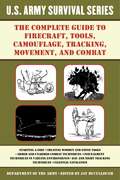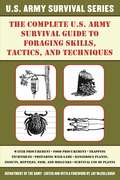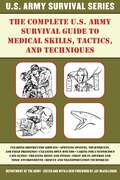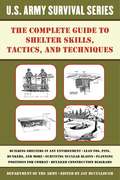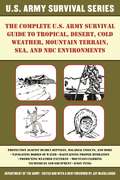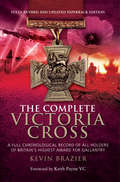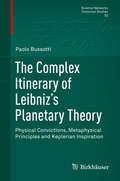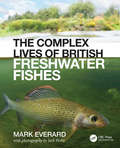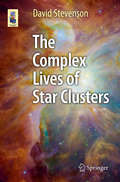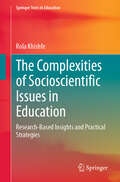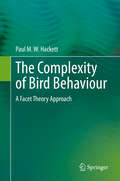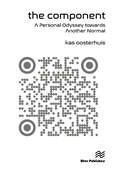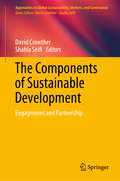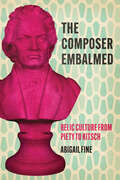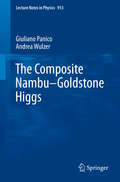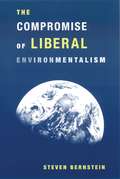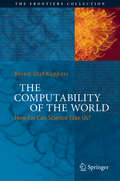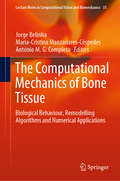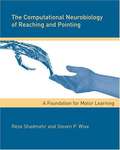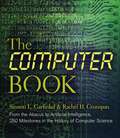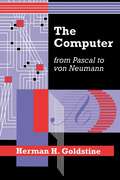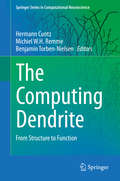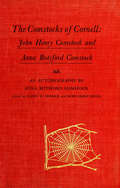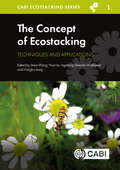- Table View
- List View
The Complete U.S. Army Survival Guide to Firecraft, Tools, Camouflage, Tracking, Movement, and Combat (US Army Survival)
by Army Jay McCulloughIn this vital guide, you’ll find important techniques of wielding firecrafts, constructing tools, creating camouflage, and tracking a prey’s movement. From step-by-step instructions on crafting a flint knife to tips on beating an opponent in close combat, The Complete U.S. Army Survival Guide to Firecraft, Tools, Camouflage, Tracking, and Movement has got you covered. Within these pages you’ll find: Guidelines on selecting the best site to start a fire The most effective moves to use against an opponent in any range of combat How-to chose an optimal location for cover in any terrain Instructions for tracking the movement of dozens of different animals And dozens more critical techniques!With dozens of photographs and illustrations demonstrating techniques and procedures first-hand, this guide is an essential read for every outdoorsman-from the novice weekend camper to the most seasoned survivalist. If you can’t find it within the pages of The Complete U.S. Army Survival Guide to Firecraft, Tools, Camouflage, Tracking, and Movement, then you don’t really need it.
The Complete U.S. Army Survival Guide to Foraging Skills, Tactics, and Techniques
by Jay McCulloughHere in this critical guide is all the important foraging techniques that you’ll need to know in order to survive in just about any situation. From selecting edible berries to trapping small game, The Complete U.S. Army Survival Guide to Foraging Skills, Tactics, and Techniques has got you covered. Within these pages, you’ll find: The proper procedure to construct a water distillery How to discern the difference between poisonous and deadly plants. A step-by-step guide to expertly skinning and cooking a squirrel. And hundreds more critical foraging techniques.With dozens of photographs and illustrations demonstrating these medical techniques and procedures first-hand, this guide is an essential read for every outdoorsman-from the novice weekend camper to the most seasoned survivalist. If you can’t find it in The Complete U.S. Army Survival Guide to Foraging Skills, Tactics, and Techniques, then you don’t really need it.
The Complete U.S. Army Survival Guide to Medical Skills, Tactics, and Techniques (US Army Survival)
by Jay McCulloughHere in this critical guide is all the important medical techniques that you’ll need to know in order to survive in just about any situation. From wrapping life-threatening head wounds to treating a poisonous spider bite, The Complete U.S. Army Survival Guide to Medical Skills, Tactics, and Techniques has got you covered. Within these pages, you’ll find: First-aid techniques for hundreds of different kinds of wounds. Medical procedures necessary for properly treating animal bites and stings. Proper procedures to follow when dealing with toxic environments. And thousands more essential medical tips.With dozens of photographs and illustrations demonstrating these medical techniques and procedures first-hand, this guide is an essential read for every outdoorsman-from the novice weekend camper to the most seasoned survivalist. If you can’t find it in The Complete U.S. Army Survival Guide to Medical Skills, Tactics, and Techniques, then you don’t really need it.
The Complete U.S. Army Survival Guide to Shelter Skills, Tactics, and Techniques (US Army Survival)
by Jay McCulloughHere in this critical guide is all the important safety techniques that you’ll need to know in order to survive in just about any condition. From designing a makeshift earthquake shelter to constructing a water well, The Complete U.S. Army Survival Guide to Shelter Skills, Tactics, and Techniques has got you covered. Within these pages, you’ll find information on the best way to: Choose the best building materials. Select the best ambushing positions in any situation. Construct an underground bunker. And hundreds of more techniques and skillsWith dozens of photographs and illustrations demonstrating these sheltering techniques and procedures first-hand, this guide is an essential read for every outdoorsman-from the novice weekend camper to the most seasoned survivalist. If you can’t find it in The Complete U.S. Army Survival Guide to Shelter Skills, Tactics, and Techniques, then you don’t really need it.
The Complete U.S. Army Survival Guide to Tropical, Desert, Cold Weather, Mountain Terrain, Sea, and NBC Environments
by Army Jay McCulloughWithin this indispensable guide, you’ll find every tip that you’ll ever need to thrive in any type of landscape, in any degree of climate. From managing the heat of the tropics to combatting the chill of the mountaintops, The Complete U.S. Army Survival Guide to Desert, Forest, Jungle, Plain, Mountain, and Urban Environment has got you covered. Within these pages you’ll discover such vital tips as: How-to treat hypothermia The correct method of righting a capsized craft Tips for minimizing the dire effects of chemical exposure And dozens more crucial survival tips!With dozens of photographs and illustrations demonstrating these procedures and techniques first-hand, this guide is an essential read for every outdoorsman-from the novice weekend camper to the most seasoned survivalist. If you can’t find it in The Complete U.S. Army Survival Guide to Desert, Forest, Jungle, Plain, Mountain, and Urban Environment then you don’t really need it.
The Complete Victoria Cross: A Full Chronological Record of All Holders of Britain's Highest Award for Gallantry
by Kevin BrazierThis fully revised paperback edition of the complete chronological record of VC holders is an essential work of reference for every student of military history. All the British and Commonwealth servicemen who have been awarded the highest honour for exceptional acts of bravery and self-sacrifice are commemorated here. The first VCs awarded for the Crimean War and in the nineteenth-century colonial wars are described, as are the VCs awarded in the world wars of the twentieth century and the most recent VCs awarded during present-day conflicts in Iraq and Afghanistan. The extraordinary exploits recounted in this fascinating book make unforgettable reading.
The Complex Itinerary of Leibniz's Planetary Theory
by Paolo BussottiThis book presents new insights into Leibniz's research on planetary theory and his system of pre-established harmony. Although some aspects of this theory have been explored in the literature, others are less well known. In particular, the book offers new contributions on the connection between the planetary theory and the theory of gravitation. It also provides an in-depth discussion of Kepler's influence on Leibniz's planetary theory and more generally, on Leibniz's concept of pre-established harmony. Three initial chapters presenting the mathematical and physical details of Leibniz's works provide a frame of reference. The book then goes on to discuss research on Leibniz's conception of gravity and the connection between Leibniz and Kepler.
The Complex Lives of British Freshwater Fishes
by Mark EverardThis stunningly illustrated book goes far beyond a run-of-the-mill nature guide. It explores the fascinating life histories of Britain’s freshwater fishes, a group of animals which, despite their importance and ubiquity in our diverse still and flowing fresh waters, has before now been rarely regarded and respected as 'wildlife'. Our native fishes tend generally to be considered as simply something for anglers to catch or for people to eat, yet they work enormously hard for us. Author Mark Everard, avid nature-watcher, angler and scientist, shows how freshwater fish provide food, ornamentation, sport and cultural identity, and highlights their huge importance for conservation as part of the living ecosystems upon which we all depend. He dives into the mysteries moving below the surface of our rivers and lakes, bringing the wonderful and fascinating world of the diversity of British freshwater fish species into plain sight and into mind. This unique book features over 100 full-colour photographs by pioneering photographer and filmmaker Jack Perks, whose work has featured on BBC Springwatch, The One Show and Countryfile. The book is filled with technical detail useful to conservationists and biology students. Most importantly, it is also presented in an accessible, visually attractive and engaging manner that will appeal to anybody with an interest in the natural world: the conservation-minded public, the angling community, and our nation of wildlife enthusiasts. Whatever your background, this book will open your eyes to our freshwater fishy wealth, and the many ways in which it enriches our lives.
The Complex Lives of Star Clusters
by David StevensonAs with the author's recent books Extreme Explosions and Under a Crimson Sun, the complex topic of star clusters is broken down and made accessible with clear links to other areas of astronomy in a language which the non-specialist can easily read and enjoy. The full range of topics are addressed regarding how star clusters are formed. Why is it some are dense conglomerates of stars while others are looser associations? Are the young, brilliant clusters seen in neighboring galaxies such as the Large Magellanic Cloud, M33 or M82 analogous to the ancient globulars seen in the Milky Way? How will these clusters change as their stars wane and die? More interestingly, how does living in a dense star cluster affect the fates of the stars and any attendant planets that accompany them? Star clusters form many of the most dazzling objects in the astronomers' catalogs. Many amateur astronomers are interested in exploring how these objects are created and what it would be like to live among these objects. From the historical views of how star clusters came about to the most recent assumptions about how stars within these clusters evolve, different strands of science, from observation to theory, are woven together into a compelling investigation specifically targeted at amateur astronomers.
The Complexities of Socioscientific Issues in Education: Research-Based Insights and Practical Strategies (Springer Texts in Education)
by Rola KhishfeThis textbook is an essential scholarly resource that explores the complexities of socioscientific issues (SSI), presenting scenarios that serve as an overview of crucial concerns. It is designed to give students a nuanced perspective as they navigate the intersections of science, ethics, and society. It aims to develop critical thinking abilities and enhance informed decision-making by encouraging students to think critically, evaluate evidence, and support their viewpoints. It examines these issues across various scientific fields, presenting scenarios designed to enhance critical thinking and informed decision-making by encouraging students to evaluate evidence and support their viewpoints. This publication includes socioscientific issues from around the world that address the disciplines of biology, chemistry, physics, and environmental science. This volume is an invaluable resource for science educators and policymakers, as it provides practical insights and research-based strategies for enhancing scientific literacy and fostering a deeper understanding of the ethical dimensions of science in our interconnected world.
The Complexity of Bird Behaviour: A Facet Theory Approach (Springerbriefs In Animal Sciences Ser.)
by Paul M. HackettThis book presents the facet theoretical framework as a tool for facilitating the conception of complex animal behaviour research and the design of research procedures through employing mapping sentences. Using the facet theoretical framework, this book takes a holistic view of bird behaviour. Components of bird behavior are identified and then reassembled to facilitate an understanding of the behaviour in the context of its natural occurrence. This provides new insight on both the parts of the behaviour and how these interact as a whole. The multi-faceted approach to designing, evaluating and understanding bird behavior presented offers a template that is adaptable for investigating a wide variety of avian species and different forms of behaviour.Behavioural biologists, animal and comparative psychologists, other natural and behavioural scientists, as well as students of these disciplines will find this book to be an interesting and enlightening read.
The Component: A Personal Odyssey towards Another Normal (River Publishers Series in Social, Urban, Economic and Environmental Sustainability)
by Kas OosterhuisThe Component: A Personal Odyssey towards Another Normal is the Oosterhuis' personal account of four decades of architectural and societal thinking, designing, building, and theorizing. It is an orchestrated yet non-linear series of subjects all leading toward the creation of a parallel world called "Another Normal." Another Normal is as of now a hypothetical parallel world. Nomadic international citizens are the inhabitants of Another Normal. Urged by the climate crisis, the food, energy, and water nexus, and the COVID-19 pandemic, Another Normal demonstrates the inevitable data-driven techno-social architecture of the physically built environment and the metaverse. Besides robotic production on demand of almost anything – when, where, and as needed – Oosterhuis' proposes a dozen strategies that run in parallel to establish Another Normal, among others: ubiquitous basic income, global birthright to own a generous piece of land, distributed production of healthy food, clean energy, and drinking water, ownership of private data and personal avatars in the Web 3.0, autonomous electronic transportation, ubiquitous shared responsibility for clean production and waste treatment techniques, ubiquitous home delivery, working from anywhere for any period of time, and decentralized real-time peer to peer banking. The organic real and the synthetic hyper-real co-evolve naturally in Another Normal, where a mix of strong and simple legislative, planning, and design rules create complexity, diversity, fairness, and equality.
The Components of Sustainable Development: Engagement and Partnership (Approaches to Global Sustainability, Markets, and Governance)
by David Crowther Shahla SeifiThis book focuses on the application of sustainable development principles through consultation with, and partnerships between commerce and the community. Offering international perspectives, the authors show that the issues are global and that we can best arrive at solutions through a synthesis of these various perspectives. The book also examines changes to corporate and institutional behavior and discusses the extent to which the focus has changed, making it necessary to consider new approaches to our understanding of sustainability and differing effects in practice.This approach is based on the tradition of the Social Responsibility Research Network, which in its 17-year history has sought to broaden the discourse and to treat all research as inter-related and relevant to business. This book consists of the best contributions from the 17th International Conference on Corporate Social Responsibility and 8th Organisational Governance Conference, held in Bangalore, India in September 2018
The Composer Embalmed: Relic Culture from Piety to Kitsch (New Material Histories of Music)
by Abigail FineThe first granular study of nineteenth-century composer devotion—a network of devotees who preserved tangible traces of composers through relics, rituals, pilgrimage, exhumation, and embalming. During the nineteenth century, music institutions promoted artworks they deemed timeless and made composers into figureheads of a lasting Western canon. Alongside this institutional face of the canon was a more intimate impulse to preserve, touch, and embrace the residues of the dead. In Germany and Austria between 1870 and 1930, music lovers venerated the bodies, houses, and belongings of composers as relics, shrines, and talismans. In The Composer Embalmed, Abigail Fine documents the vernacular and eccentric ways that composers have been remembered. Fine navigates a wealth of unknown archival material to recover the stories of devotees: from pilgrims who felt time stop in historic houses to music-loving doctors who made skulls into sacred specimens, dilettantes who displayed Beethoven’s mask as a relic of the “beautiful death,” and interwar critics of those dilettantes who disparaged piety as a false religion, a kitsch replica. In isolation, these practices may look like simple acts of affection. But in the aggregate, Fine asserts, acts of devotion constituted what we might broadly understand as relic culture—a culture that sought to possess the body of the departed genius, and that superimposed habits of anthropological collecting onto artifacts of Austro-German heritage. By excavating objects, ephemera, amateur lyric, visitors’ books, letters, and travelogues, The Composer Embalmed reveals the underbelly of the canon, where guilty pleasures blur the boundary between sanctity and desecration.
The Composite Nambu-Goldstone Higgs
by Giuliano Panico Andrea WulzerThe Hierarchy Problem is arguably the most important guiding principle concerning the extension to high-energy scales of the Standard Model (SM) of Fundamental Interactions. Every scenario for addressing this issue unavoidably predicts new physics in the TeV energy range, which is currently being probed directly by the LHC experimental program. Among the possible solutions to the Hierarchy Problem, the scenario of a composite Higgs boson is a very simple idea and a rather plausible picture has emerged over the years by combining the following ingredients: First, the Higgs must be a (pseudo-) Nambu-Goldstone boson, rather than a generic hadron of the new strong sector. Second, through the so-called 'partial compositeness', SM particles mix with strong sector resonances with suitable quantum numbers, so that they become a linear combination of elementary and composite degrees of freedom. Recently, general descriptions of the Composite Higgs Scenario were developed which successfully capture the relevant features of this theoretical framework in a largely model-independent way. The present book provides a concise and illustrative introduction to the subject for a broad audience of graduate students and non-specialist researchers in the fields of particle, nuclear and gravitational physics.
The Composition of Kepler's Astronomia nova
by James R. VoelkelThis is one of the most important studies in decades on Johannes Kepler, among the towering figures in the history of astronomy. Drawing extensively on Kepler's correspondence and manuscripts, James Voelkel reveals that the strikingly unusual style of Kepler's magnum opus, Astronomia nova (1609), has been traditionally misinterpreted. Kepler laid forth the first two of his three laws of planetary motion in this work. Instead of a straightforward presentation of his results, however, he led readers on a wild goose chase, recounting the many errors and false starts he had experienced. This had long been deemed a ''confessional'' mirror of the daunting technical obstacles Kepler faced. As Voelkel amply demonstrates, it is not. Voelkel argues that Kepler's style can be understood only in the context of the circumstances in which the book was written. Starting with Kepler's earliest writings, he traces the development of the astronomer's ideas of how the planets were moved by a force from the sun and how this could be expressed mathematically. And he shows how Kepler's once broader research program was diverted to a detailed examination of the motion of Mars. Above all, Voelkel shows that Kepler was well aware of the harsh reception his work would receive--both from Tycho Brahe's heirs and from contemporary astronomers; and how this led him to an avowedly rhetorical pseudo-historical presentation of his results. In treating Kepler at last as a figure in time and not as independent of it, this work will be welcomed by historians of science, astronomers, and historians.
The Compromise of Liberal Environmentalism
by Steven BernsteinThe most significant shift in environmental governance over the last thirty years has been the convergence of environmental and liberal economic norms toward "liberal environmentalism"—which predicates environmental protection on the promotion and maintenance of a liberal economic order. Steven Bernstein assesses the reasons for this historical shift, introduces a socio-evolutionary explanation for the selection of international norms, and considers the implications for our ability to address global environmental problems.The author maintains that the institutionalization of "sustainable development" at the 1992 United Nations Conference on Environment and Development (UNCED) legitimized the evolution toward liberal environmentalism. Arguing that most of the literature on international environmental politics is too rationalist and problem-specific, Bernstein challenges the mainstream thinking on international cooperation by showing that it is always for some purpose or goal. His analysis of the norms that guide global environmental policy also challenges the often-presumed primacy of science in environmental governance.
The Computability of the World: How Far Can Science Take Us? (The Frontiers Collection)
by Bernd-Olaf Küppers Paul WoolleyIn this thought-provoking book Küppers, an internationally renowned physicist, philosopher and theoretical biologist, addresses a number of science's deepest questions: Can physics advance to the origin of all things and explain the unique phenomena of life, time and history? Are there unsolvable enigmas of the world? How did life originate? Is language a general phenomenon of Nature? What is time? Is it possible to express the history of the world in formulae? Where is science leading us? These and other provocative questions essential for a deeper understanding of the world are treated here in a refreshing and stimulating manner.
The Computational Mechanics of Bone Tissue: Biological Behaviour, Remodelling Algorithms and Numerical Applications (Lecture Notes in Computational Vision and Biomechanics #35)
by Jorge Belinha Maria-Cristina Manzanares-Céspedes António M. G. CompletoThis book offers a timely snapshot of computational methods applied to the study of bone tissue. The bone, a living tissue undergoing constant changes, responds to chemical and mechanical stimuli in order to maximize its mechanical performance. Merging perspectives from the biomedical and the engineering science fields, the book offers some insights into the overall behavior of this complex biological tissue. It covers three main areas: biological characterization of bone tissue, bone remodeling algorithms, and numerical simulation of bone tissue and adjacent structures. Written by clinicians and researchers, and including both review chapters and original research, the book offers an overview of the state-of-the-art in computational mechanics of bone tissue, as well as a good balance of biological and engineering methods for bone tissue analysis. An up-to-date resource for mechanical and biomedical engineers seeking new ideas, it also promotes interdisciplinary collaborations to advance research in the field.
The Computational Neurobiology of Reaching and Pointing: A Foundation for Motor Learning
by Reza Shadmehr Steven P. WiseThis book presents an introduction to the computational neurobiology of reaching and pointing--with emphasis on motor learning in primates--based on an eclectic selection of topics.
The Computer Book: From the Abacus to Artificial Intelligence, 250 Milestones in the History of Computer Science (Union Square & Co. Milestones)
by Simson L Garfinkel Rachel H. GrunspanPart of Sterling&’s extremely popular Milestones series, this illustrated exploration of computer science ranges from the ancient abacus to superintelligence and social media. With 250 illustrated landmark inventions, publications, and events—encompassing everything from ancient record-keeping devices to the latest computing technologies—this highly topical addition to the Sterling Milestones series takes a chronological journey through the history and future of computer science. Two expert authors, with decades&’ of experience working in computer research and innovation, explore topics including the Sumerian abacus, the first spam message, Morse code, cryptography, early computers, Isaac Asimov&’s laws of robotics, UNIX and early programming languages, movies, video games, mainframes, minis and micros, hacking, virtual reality, and more.
The Computer from Pascal to von Neumann
by Herman H. GoldstineIn 1942, Lt. Herman H. Goldstine, a former mathematics professor, was stationed at the Moore School of Electrical Engineering at the University of Pennsylvania. It was there that he assisted in the creation of the ENIAC, the first electronic digital computer. The ENIAC was operational in 1945, but plans for a new computer were already underway. The principal source of ideas for the new computer was John von Neumann, who became Goldstine's chief collaborator. Together they developed EDVAC, successor to ENIAC. After World War II, at the Institute for Advanced Study, they built what was to become the prototype of the present-day computer. Herman Goldstine writes as both historian and scientist in this first examination of the development of computing machinery, from the seventeenth century through the early 1950s. His personal involvement lends a special authenticity to his narrative, as he sprinkles anecdotes and stories liberally through his text.
The Computing Dendrite
by Hermann Cuntz Michiel W. H. Remme Benjamin Torben-NielsenNeuronal dendritic trees are complex structures that endow the cell with powerful computing capabilities and allow for high neural interconnectivity. Studying the function of dendritic structures has a long tradition in theoretical neuroscience, starting with the pioneering work by Wilfrid Rall in the 1950s. Recent advances in experimental techniques allow us to study dendrites with a new perspective and in greater detail. The goal of this volume is to provide a résumé of the state-of-the-art in experimental, computational, and mathematical investigations into the functions of dendrites in a variety of neural systems. The book first looks at morphological properties of dendrites and summarizes the approaches to measure dendrite morphology quantitatively and to actually generate synthetic dendrite morphologies in computer models. This morphological characterization ranges from the study of fractal principles to describe dendrite topologies, to the consequences of optimization principles for dendrite shape. Individual approaches are collected to study the aspects of dendrite shape that relate directly to underlying circuit constraints and computation. The second main theme focuses on how dendrites contribute to the computations that neurons perform. What role do dendritic morphology and the distributions of synapses and membrane properties over the dendritic tree have in determining the output of a neuron in response to its input? A wide range of studies is brought together, with topics ranging from general to system-specific phenomena--some having a strong experimental component, and others being fully theoretical. The studies come from many different neural systems and animal species ranging from invertebrates to mammals. With this broad focus, an overview is given of the diversity of mechanisms that dendrites can employ to shape neural computations.
The Comstocks of Cornell: John Henry Comstock and Anna Botsford Comstock
by Anna Botsford ComstockThe Comstocks of Cornell is the autobiography written by naturalist educator Anna Botsford Comstock about her life and her husband's, entomologist John Henry Comstock—both prominent figures in the scientific community and in Cornell University history.A first edition was published in 1953, but it omitted key Cornellians, historical anecdotes, and personal insights. Karen Penders St. Clair's twenty-first century edition returns Mrs. Comstock's voice to her book by rekeying her entire manuscript as she wrote it, and preserving the memories of the personal and professional lives of the Comstocks that she had originally intended to share. The book includes a complete epilogue of the Comstocks' last years and fills in gaps from the 1953 edition. Described as serious legacy work, the book is an essential part of Cornell University history and an important piece of Cornell University Press history.
The Concept of Ecostacking: Techniques and Applications (Ecostacking Series)
by James D Blande Heikki M.T. Hokkanen Jarmo K Holopainen Tomislav Cernava Xian Wang Dr Ingeborg Menzler-Hokkanen Fanny Boerave Dr Daniel Carrillo Xiaoyulong Chen Wen-Qiang Chu Gloria Gauthura Severin Hatt Fathiya Khamis Pål Kvello Guang-Yun Li Dr Yaying Li Beatrice Muriithi Jinzhi Niu Levi Ombura Ziying Wang Qiu Yang Wei Yixia Wu Li Ya-Ying Kaijun ZhangEcostacking is a new concept and approach which aims to maximize the benefits of ecosystem service providers in cropping systems to help achieve the goal of long-term sustainable agriculture and food production. The term "ecostacking" means combining synergistically the beneficial services of functional biodiversity from all levels and types. It is a comprehensive approach, where the various ecosystem service providers are fully integrated with the rest of the cropping system including agronomic practices. It is an approach which goes beyond conventional Integrated Pest Management practises, and attempts to take advantage of all the functional biodiversity of a system. The main focus of ecostacking is on maximizing ecosystem services for biological control and pollination from beneficial arthropods, but the approach also utilizes other invertebrates (e.g., earthworms) as well as beneficial vertebrates such as bats, birds and small mammals. Microbes also provide invaluable ecosystem services including pest, disease, and weed control, either directly as components of "suppressive soils" or as plant colonizers (as endophytes or as epiphytic microbial flora). The ecostacking approach also aims to maximize other nature-provided services such as maintenance of soil health and nutrient cycling. The Concept of Ecostacking is the first book in a series which introduces ecostacking concepts to the reader and explores how this approach can be used in a variety of ways and in different cropping systems. The book defines this new concept and shows, using illustrative case studies from around the world, how ecostacking principles can be successfully employed in cropping systems in the open field, in greenhouses and in forestry. This book: · will serve as inspiration for developing further applications of this breakthrough technology for sustainable agricultural production. · is a must-read for everyone with an interest in developing sustainable crop protection systems and ecosystem management. · has been written and edited by the world's leading experts in this new and exciting endeavour.
